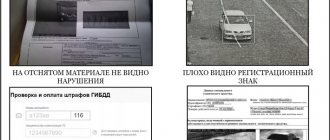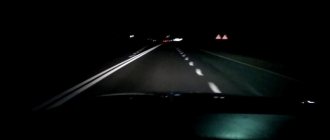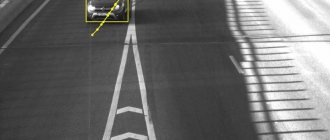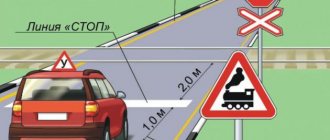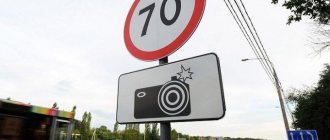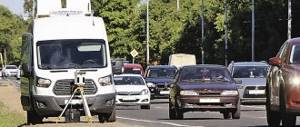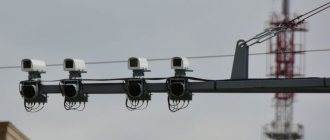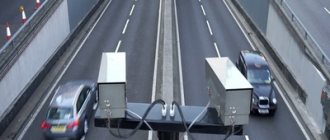How cameras work
At the moment, there are many types of cameras for video and photographic recording of traffic violations.
They vary in range, mobility, types of impairments, and so on. Some of them can only work during the day, while others can work at any time of the day. Below are the average characteristics of such cameras:
- range of fixed speeds - 20 - 250 km/h;
- overview of cameras about 10 meters wide, 8 m to 1 km long;
- File storage time is usually from 10 minutes.
There are stationary and mobile fixation stations. Stationary ones are mounted above the roadway on metal structures. To accurately measure the speed of moving cars, they are mounted in a certain position, at an angle to the road.
The camera measures the vehicle's speed between two viewpoints. Everything is calculated automatically - the time it takes the car to travel a certain distance is recorded. From which the speed with which she did it is calculated.
Errors in such cameras can occur as a result of camera misalignment. If, for example, the camera is mounted on the underside of a bridge, vibration may cause it to become dislodged over time. Accordingly, the control distance actually decreases, but the camera “does not know” about this and continues to calculate the speed from a smaller section of the road using the original parameters.
Thus, even conscientious drivers can suffer from camera displacement. To avoid such incidents, road services regularly check violation detection devices.
Mobile stations can be located anywhere on the road. They work both on the move and from a standstill. Such cameras are most often located in cars. Typically, the device detects only one lane of traffic.
How many meters before the car do cameras start recording speeding?
To record traffic violations, bulky units attached to patrol cars and hand-held radars have not been used for a long time. They have been replaced by high-tech recording cameras, characterized by high resolution and a host of additional functions.
Many motorists ask questions: at what distance do devices begin to record speeding and what else are high-tech law enforcement officers capable of?
The capabilities of the latch depend on its modification. There are several of these:
- “Chris”, “Arena” are the simplest models. They make up the bulk of road surveillance devices. Radars are capable of detecting an intruder at a distance of no more than 100 m.
- “Cordon” and “Krechet” have more power and recognize reckless drivers at a distance of 150 m. Cameras record both approaching and retreating cars. They are very rare on the roads.
- Strelka is the most forward-thinking surveillance camera. The coverage area of the Strelka radar is 250 m.
The fixed distance also depends on external factors: weather conditions, time of day, etc. There are systems consisting of several cameras located in a row. Their coverage area depends on the number of devices. In certain cases, it can cover kilometers of travel.
Photo recording of the offending vehicle occurs at a distance of 50 to 70 m from the location where the fixing device is attached. Experienced reckless drivers, getting into the radar zone, begin to maneuver.
The response of the fixator depends on its technical capabilities. The surveillance system can simply “forget” the reckless driver. But often the cameras get confused and photograph the license plates of cars driving nearby. Thus, a completely different driver receives a fine.
It's the same with motorcycles. Photo recording devices do not have the technical ability to recognize the license plate of a given vehicle. Therefore, the car that was closest to the motorcycle at the time of photographing receives a fine for speeding.
How the system works
Cameras are installed not only on highways, but also within the city.
The device records:
- automobile;
- license plate;
- date;
- time;
- the violation itself.
It is important to know: recording the driver’s identity is not necessary - the owner of the car will receive a fine.
Violations that may be captured include:
- speeding by more than 20 km/h;
- crossing a solid marking line (entering the oncoming lane);
- driving through a prohibitory traffic light sign;
- improper parking;
- roadside travel;
- crossing the stop line.
When a violator is caught on camera, data about the violation and the vehicle are sent to the traffic police server. Inspectors, having received the information, remove controversial and low-quality photos, verify data about the vehicle and transmit the information to inspectors.
Traffic police officers re-verify the information received and impose an administrative penalty. And only after that the printed letter is packed into an envelope and sent to the place of registration of the car owner.
Even if the violation occurred in another region, you will still receive a fine. The traffic police bases are the same, so you shouldn’t relax “while visiting.”
Operating principle of average speed cameras
The speed of a moving vehicle can be measured as average or instantaneous. It all depends on the functional features of the camera and software. In the case of measuring average speed, a set of radars is used, located on a certain section of the highway.
Avtodoriya complex
Calculates the average speed on a certain section of the road, which can be either a couple of hundred meters or reach several kilometers. These complexes do not contain a radar part. In fact, at the beginning and end of the calculated section, photographic recording is made, which is designed to record the time interval between the moments of being at given points. The system knows the distance in advance. Given two variables, the system will automatically calculate the average driving speed. Even such a seemingly simple system fails. The fact is that cases cannot be completely ruled out when, given the similarity of cars and their license plates, the system identifies objects as the same transport, as a result of which, if both drivers do not have an offense, one of the car owners may receive an unfounded letter from fine
Vocord system
For this system, one camera is enough to determine the average speed of transport, since such cameras take several pictures in a row on a certain section of the road. Radars are also not used for these systems, but due to the limited distance at which photographic recording and calculation of the object’s speed takes place, the result obtained will be as close as possible to the actual speed.
Complex "Avtouragan"
The complex’s cameras calculate the speed of an object’s movement using a “certified optical method from a video image,” which is a measurement of the parameters of the observed object in the frame. The object is not the parameters of the entire vehicle, but only its license plate.
Radar "Cordon"
During fixation, the radar simultaneously recognizes the vehicle license plate, determines the coordinates and calculates the speed.
Despite the variety of video recording systems and complexes based on different operating principles, there is no universal complex that works without failures and errors. The main reason for such errors is problems in the software, most often these are caused by viruses and glitches, but there are also more prosaic ones - for example, weather conditions that influenced the change (shift) in the location of the camera.
What should be in the letter
When you receive a fine in your mailbox, you should carefully read the contents of the envelope.
It happens that several, at first glance, identical letters arrive with the same violation. Here you should pay attention to the specified date and time of the photo. Perhaps you violated several times on one section of the road.
In this case, you should pay all fines. If the dates and times in the photographs coincide, you must contact the traffic police for clarification.
The letter must include the following information:
- car model;
- registration number;
- owner's last name;
- home address;
- date and time the violation was recorded;
- address where the violation was recorded;
- the essence of the violation itself;
- photo (possibly).
If such a resolution does not contain a photo, this does not mean that the letter can be thrown away and forgotten. It is better to immediately check for fines on the traffic police website to avoid further problems.
From what distance does the camera “shoot” in terms of speed?
The average duration of the “control” path is from 100 to 250 meters, depending on the type of police camera. In this case, the sign should not be taken into account at all - there are no specific requirements for the distance of its stop from the camera.
Example: On a section of a motorway with a speed limit of 130 km/h there is a section 1 km long. at a speed of 90 km/h. The “Photo and Video Recording” sign was installed at the same time as the speed limit sign. It is unknown where and on what part of the road the camera is located. It doesn't matter if she's even standing there.
Approximate MAXIMUM operating distances for individual violation video recording devices:
- KRIS-P – up to 120 meters;
- Arrow up to 100 meters (up to 250 - modern and special modifications);
- Cordon – up to 150 meters;
- Gyrfalcon - up to 150 meters;
- Arena – up to 100 meters.
These are the most “standard” and most common devices on public roads on federal and regional highways.
In large cities, including the capital, more advanced means of control are used - such as “Pit stop” or “autourgana”. All of them are “sharpened” to quickly identify vehicles driving in violation of the rules in heavy traffic.
Use of video materials in violation
The practice of catching violators via video is widely used.
For example, any driver can record a violation on camera and send it to the traffic police. Having received the video, inspectors conduct an inspection and find the violator through a single database. After which a “letter of happiness” is generated and sent, also to the place of registration of the car owner.
This is interesting! Fine for driving into the oncoming lane: what the traffic rules say
In addition, many patrol vehicles are equipped with recording devices. Having recorded a violation, the inspectors stop the main character of the video and draw up a report.
In this case, the driver should look at the recording itself and make sure that the actions of the traffic police officers are legal. If, after viewing the recording, you still have doubts about the legality of the actions of the traffic police officers, you can challenge the protocol. To do this, you need to indicate in the document itself that you do not agree with the protocol.
Next, having received a copy of it and collected evidence of your innocence, you need to go to court. The evidence may include recordings from your dash cam and witness statements, if any.
Rules for installing private video cameras
Meanwhile, rules for installing mobile video equipment exist, are regulated by the Administrative Regulations of the Ministry of Internal Affairs of the Russian Federation (clauses 43, 55-57) and quite clearly interpret the responsibilities of persons conducting video recording of traffic violations.
Mobile video recording cameras can be installed by commercial organizations that have entered into a concession agreement in the following places:
- increased accident risk on roads;
- where there is no stationary video recording;
- which are designated by the leadership of the local traffic police department;
- where they can be seen by drivers from afar.
Each camera must be tested and certified by the traffic police, and operating personnel must undergo special training and testing. Each video recording crew (2 people) must have a package of documents on hand: certificates for equipment and qualifications of specialists, a visa from the head of the regional traffic police for the right to perform these works, indicating the exact location of the video camera installation on a specific section of the road.
Rules for installing a video recording device
From June 1, 2013, on the road where static cameras for automatically recording violations are installed, a warning sign must be installed, and special road markings must be applied.
In the traffic rules, the sign has the number 8.23, and it shows a camera taking a picture (with a flash), the markings are done in the same form.
By observing such a sign or road markings, you can be completely sure that a camera will be located ahead.
But this does not apply to mobile cameras that record speed violations. Mobile speed meters can be installed at any other time, and therefore, of course, no one will put up signs or draw markings on the road every time. Therefore, these cameras are installed mostly secretly, and sometimes even disguised, so that an unsuspecting violator is noticed and punished.
Before the camera is installed, the administrative authority must issue permission for its installation in a given location . In addition to the location, the permit must contain technical information about the camera itself and its operating mode.
